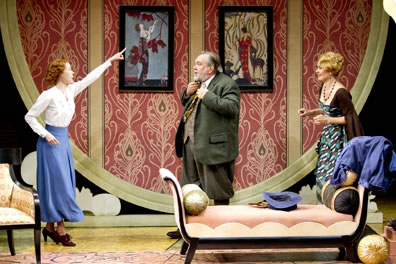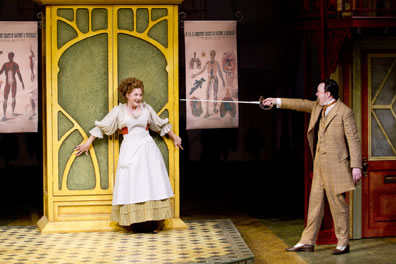The Merry Wives of Windsor
A War-Weary Windsor on the Make
Is Still a Merry Place to Be
Shakespeare Theatre Company, Sidney Harman Hall, Washington, D.C.
Wednesday, June 20, 2012, D–121 & 120 (center left stalls)
Directed by Stephen Rayne
The moment of truth occurs at the start of the play’s last scene, when the stage lights come up to reveal Falstaff wearing deer antlers. This can be a ridiculous moment or a confusing one; but just the mere revelation of David Schramm’s Falstaff outfitted as Herne the Hunter earns the biggest laugh of a laugh-filled night. Schramm’s lived-in portrayal of the fat knight achieves this comic crowning, and this Shakespeare Theatre Company’s season-ending production of The Merry Wives of Windsor crowns itself by adeptly integrating Shakespeare’s tacked-on masque finale into the humorous flow of the whole play.

Mistress Page (Veanne Cox) directs Falstaff (David Schramm) upstairs to change into the old woman of Brentford as Mistress Ford (Caralyn Kozlowski) waches in the Shakespeare Theatre Company's production of The Merry Wives of Windsor. Photo by Scott Suchman, Shakespeare Theatre Company.
The triumph is remarkable given how much effort director Stephen Rayne put into this production's conceptual setting, transferring the play’s from Elizabethan Windsor to 1919 Windsor, England. Rayne saw much correlation in the two time frames. In the former, soldiers were returning from overseas wars to a bankrupt nation and societal seismic shifts, with a rising middle class and a fiscally strapped nobility. In 1919, soldiers were again returning from an overseas war to a bankrupt nation and a society undergoing more seismic shifts, with the women’s suffrage movement taking hold and the landed gentry becoming obsolete.
Thus, the play opens with Falstaff parading his army across the stage as cheering townspeople welcome them home. The second half opens with Mistress Page leading a suffragette march. Throughout, this production served up the extraneous busyness typical of an STC Shakespearian presentation, such as pedestrians strolling back and forth or Hugh Evans’s school kids marching across the stage while pieces of scenery flew or glided on and off stage for the next scene. Making sure he kept all these conceptual elements intact even as the play ran overlong, Rayne opted to cut out the Latin lesson scene and Brook’s third meeting with Falstaff (also cut was the German subplot, but that’s no great loss).
Daniel Lee Conway’s set looked charming, with ironwork frivolity ornamenting the Windsor town square, a red statue of Queen Victoria (against which Falstaff, dressed as the old woman of Brenford, compared himself), and a music hall–style backdrop featuring a painting of Windsor Castle (a fitting choice, as the castle is ever-present in Shakespeare’s text). It was yet a clunky set, with spiral staircases on the Fords’ and Pages’ homes. This is another STC Shakespeare trend, directors forcing their actors—and, consequently, the audiences’ attention—to unnecessarily traverse levels. It gives us a headache and undermines the actors’ performances. Schramm appeared for an after-show talkback wearing a cast on his foot, having injured himself climbing one of the stairways on the second night of previews.
Still, emerging out of these conceptual trappings was a funny play courtesy of a talented cast that relied on Shakespeare rather than the setting for the play’s true comic moments. Leading the way, injury notwithstanding, was Shramm, whose own physical build and appearance required little in the way of makeup to play Falstaff. We figured he’d made a career of playing the fat knight and were surprised to learn in the talkback that this was his first go at the role. Based on his performance, he certainly could make a lucrative career being today’s go-to Falstaff. Respectful of the character forged in the Henry IV plays, Schramm stays true to the sitcom character of this play, maintaining Falstaff’s intelligence while giving subtle glimpses of the schemer behind Falstaff’s more duplicitous moments. His comic timing brings fresh laughs to many of Falstaff’s lines, especially in his conversations with Mistress Quickly (delightfully played by Amy Hohn) and the disguised Ford (Michael Mastro). This is a Falstaff who has a romance-novel notion of how to court women (his first rendezvous with Mistress Ford is Barney Stinson-funny long before the buck-basket comes into play), who is seriously insulted by having to share space with dirty clothes (“grease” is the ultimate nasty for this Falstaff), and who is poignantly chagrined by his exposure in the park, though he ends up thoroughly enjoying the comeuppances Master and Mistress Page endure.
Rayne reveals a Windsor where everybody is a schemer, each individual seeking money, power, or love. Even Mistress Quickly admits that she’s plying equally for all three of Anne Page's suitors and takes obvious credit when tables turn one way or another. Her motivation is merely to be liked by everybody, the only thing of real value she could know. Hewing to this theme helps integrate the masque of the last scene; all of Windsor is coordinating to punk Falstaff, and all the while the participants are secretly planning to punk each other, too. The great incongruity in Shakespeare’s script is his casting Mistress Quickly as the lead fairy and Pistol as Hobgoblin. In Rayne’s presentation, Quickly and Pistol (played with gruff and bluff by James Konicek) form a romance over the course of the play; Shakespeare gives us Pistol’s intent to gain Quickly in their first meeting, and Rayne runs with that. Pistol in particular is getting his final revenge on the general who dismissed him, and Quickly is carrying out both the wives’ instructions and Pistol’s desire. Their roles in the masque are, Rayne reveals, fitting choices by Shakespeare.
Another character revelation in this 1919-set production is Mistress Page. Veanne Cox grounds her portrayal in a woman who has embraced female empowerment, in the streets through her suffragette activities and in her own home in her subtle manipulation of her husband (a perfectly steady Kurt Rhoads). It is Mistress Page who makes all the slogan-like proclamations of how women should be allowed to behave (i.e., “Wives may be merry, and yet honest too”). This production also highlights Mistress Page’s motivation for marrying her daughter to Dr. Caius as a means of gaining access to the doctor’s famous clients, the nobles and royals that frequent the Windsor court. While Master Page wants a tie-in to Slender’s estate money, Mistress Page sees Caius’s social connections as more valuable. Neither really care what Anne (Alyssa Gagarin) considers most valuable: a hot, motorcycle-riding wild one in Mark J. Sullivan’s Fenton.

Mistress Quickly (Amy Hohn) guards the door to the closet, where Simple is hiding, from an incensed Dr. Caius (Tom Story) in the Shakespeare Theatre Company's production of The Merry Wives of Windsor. Photo by Scott Suchman, Shakespeare Theatre Company.
The play’s other couple is not so clearly defined. Caralyn Kozlowski’s Mistress Ford displays a daffiness that takes to heart the play’s title but counters any notion of cleverness she may have. Still, she is obviously about to flourish in her own way in the coming Jazz Age. Mastro’s Ford is so uptight he’s constantly staving off impending heart attacks with nitroglycerin pills. While he is nerdy as well as nervous, we get his penchant for jealousy but little understanding of how he could be so commercially and socially successful in Windsor. Most of the humor Mastro generates is in how the other characters react to his maniacal ravings, though when he starts waving a pistol about in the second buck-basket scene our discomfort displaces the scene’s inherent comedy. However, Mastro doesn’t give up on his Ford when he finally learns the truth of the wives’ scheme; rather than becoming a milquetoast for the rest of the play, Mastro’s Ford becomes enthusiastically enamored of his sexually wily wife, and that is both funny and charming. He’s going to do just fine in the Jazz Age, too.
Shakespeare’s collection of oddball comic characters in Merry Wives is unparalleled in the rest of his canon, and they are so deliciously written that funny portrayals emerge almost naturally. That said, two performances in this production deserve special mention. Tom Story plays Dr. Caius as straight as he can rather than relying on slapstick antics. This reading gives us a true fish-out-of-water portrayal (or, rather, Frenchman-in-Windsor portrayal) that earns laughs through Caius’s gullibility. Especially funny is how the Host (Jimmy Kieffer) misleads the doctor with his vocabulary lessons. Similarly, Michael Keyloun dials down the slapstick in his Slender, earning his laughs through Shakespeare’s jokes that usually come across as too obtuse for modern audiences to appreciate. Keyloun makes Slender’s lines thoroughly accessible, and his perfect readings combined with a naïve demeanor and affected attitude results in a hilarious, rich kid without a clue, whose mother is wise to hold tight to his trust fund until after her death.
Given the acting skills on display in this production, and the fact that STC veteran Floyd King plays Hugh Evans, we miss out on what might have been the best rendering of the Latin lesson we’d ever hope to see. The 1919 Windsor setting is certainly clever and offers some useful insights. Still, when it comes to making choices between keepig the original text or the director’s conceptual interpolations, Shakespeare is almost always the merrier way to go.
Eric Minton
July 22, 2012
This review also appears on PlayShakespeare.com
Comment: e-mail editorial@shakespeareances.com.
Start a discussion in the Bardroom



 Find additional Shakespeareances
Find additional Shakespeareances